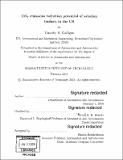| dc.contributor.advisor | Steven R. H. Barrett. | en_US |
| dc.contributor.author | Galligan, Timothy R. | en_US |
| dc.contributor.other | Massachusetts Institute of Technology. Department of Aeronautics and Astronautics. | en_US |
| dc.coverage.spatial | n-us--- | en_US |
| dc.date.accessioned | 2019-10-04T21:32:14Z | |
| dc.date.available | 2019-10-04T21:32:14Z | |
| dc.date.copyright | 2018 | en_US |
| dc.date.issued | 2018 | en_US |
| dc.identifier.uri | https://hdl.handle.net/1721.1/122397 | |
| dc.description | Thesis: S.M., Massachusetts Institute of Technology, Department of Aeronautics and Astronautics, 2018 | en_US |
| dc.description | Cataloged from PDF version of thesis. | en_US |
| dc.description | Includes bibliographical references (pages 55-60). | en_US |
| dc.description.abstract | Aviation biofuels derived from biomass and wastes have been identified as a means to reduce carbon dioxide (CO₂) emissions from US aviation, but the magnitude of the possible reduction has not been quantified. This scenario-based analysis quantifies the life cycle greenhouse gas (GHG) mitigation potential of aviation biofuels in 2050 within the US. Projected arable land availability, growth in agricultural yields, and the availability of wastes and residues are estimated as a function of future economic and climate patterns, and variability is accounted for. Under a baseline set of assumptions, the use of aviation biofuels results in a maximum reduction of 163 Tg of CO₂ equivalent (CO₂e) in 2050, a 42% reduction in life cycle GHG emissions compared to petroleum-derived jet fuel. Across all scenarios assessed, the reduction in life cycle GHGs ranges from 47.0 to 207 Tg CO₂e (12-53%), requiring the use of fuels derived from wastes, agriculture and forestry residues, and cultivated energy crops. Using only fuels derived from residues and wastes, up to 35% of US jet fuel demand could be met, corresponding to a 28% reduction of CO₂e. The results are most sensitive to assumptions on the distribution of fuel products, and agricultural residue availability. | en_US |
| dc.description.statementofresponsibility | by Timothy R. Galligan. | en_US |
| dc.format.extent | 60 pages | en_US |
| dc.language.iso | eng | en_US |
| dc.publisher | Massachusetts Institute of Technology | en_US |
| dc.rights | MIT theses are protected by copyright. They may be viewed, downloaded, or printed from this source but further reproduction or distribution in any format is prohibited without written permission. | en_US |
| dc.rights.uri | http://dspace.mit.edu/handle/1721.1/7582 | en_US |
| dc.subject | Aeronautics and Astronautics. | en_US |
| dc.title | CO₂ emissions reduction potential of aviation biofuels in the US | en_US |
| dc.title.alternative | Carbon dioxide emissions reduction potential of aviation biofuels in the US | en_US |
| dc.type | Thesis | en_US |
| dc.description.degree | S.M. | en_US |
| dc.contributor.department | Massachusetts Institute of Technology. Department of Aeronautics and Astronautics | en_US |
| dc.identifier.oclc | 1119721615 | en_US |
| dc.description.collection | S.M. Massachusetts Institute of Technology, Department of Aeronautics and Astronautics | en_US |
| dspace.imported | 2019-10-04T21:32:14Z | en_US |
| mit.thesis.degree | Master | en_US |
| mit.thesis.department | Aero | en_US |
